| How to draw | Coloring | Dotted | Dot to dot | Grid line | Draw missing | Draw other side | Jigsaw puzzle | Picture puzzle |
|
Elephant

|
Elephant

|
Elephant

|
Elephant

|
Elephant

|
Elephant

|
Elephant

|
Elephant

|
Elephant

|
|
Giraffe

|
crab

|
foot

|
aeroplane

|
golden-oriole

|
yak

|
armchair

|
dog

|
glove

|
|
Lollipop
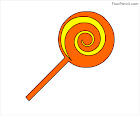
|
Trumpet
|
Grass
|
Crown
|
Recycle
|
Bottle
|
Sunglass
|
Dice
|
Pyramid
|
Saturday, 25 July 2015
How to draw a Duck step by step
How to draw Duck - step by step - Fact - Many species of duck are temporarily flightless while moulting; they seek out protected habitat with good food supplies during this period. This moult typically precedes migration.
How to draw Duck - step by step - Fact - A duckling is a young duck in downy plumage or baby duck; but in the food trade young adult ducks ready for roasting are sometimes labelled "duckling".
How to draw Duck - step by step - Fact - Southern resident species typically show less sexual dimorphism, although there are exceptions like the paradise shelduck of New Zealand which is both strikingly sexually dimorphic and where the female's plumage is brighter than that of the male. The plumage of juvenile birds generally resembles that of the female.
How to draw Duck - step by step - Fact - The overall body plan of ducks is elongated and broad, and the ducks are also relatively long-necked, albeit not as long-necked as the geese and swans. The body shape of diving ducks varies somewhat from this in being more rounded.
How to draw Duck for kids - step by step - Fact - To avoid injury when digging into sediment it has no cere, but the nostrils come out through hard horn.
How to draw Duck for kids - step by step - Fact - The ducks are generally monogamous, although these bonds generally last only a single year. Larger species and the more sedentary species (like fast river specialists) tend to have pair-bonds that last numerous years. Most duck species breed once a year, choosing to do so in favourable conditions (spring/summer or wet seasons).
How to draw Duck for kids - step by step - Fact - A male duck is called a drake and the female duck is called a duck, or in ornithology a hen.[citation needed]
How to draw Duck for kids - step by step - Fact - The wings are very strong and are generally short and pointed, and the flight of ducks requires fast continuous strokes, requiring in turn strong wing muscles. Three species of steamer duck are almost flightless, however.
How to draw cartoon Duck - step by step - Fact - Diving ducks and sea ducks forage deep underwater. To be able to submerge more easily, the diving ducks are heavier than dabbling ducks, and therefore have more difficulty taking off to fly.
How to draw cartoon Duck - step by step - Fact - Dabbling ducks feed on the surface of water or on land, or as deep as they can reach by up-ending without completely submerging.[3] Along the edge of the beak there is a comb-like structure called a pecten.
How to draw cartoon Duck - step by step - Fact - The bill is usually broad and contains serrated lamellae, which are particularly well defined in the filter-feeding species. In the case of some fishing species the bill is long and strongly serrated. The scaled legs are strong and well developed, and generally set far back on the body, more so in the highly aquatic species.
How to draw cartoon Duck - step by step - Fact - Ducklings can also be orphaned by inconsistent late hatching where a few eggs hatch after the mother has abandoned the nest and led her ducklings to water.
How to draw Duck easy - step by step - Fact - The drakes of northern species often have extravagant plumage, but that is moulted in summer to give a more female-like appearance, the "eclipse" plumage.
How to draw Duck easy - step by step - Fact - A few specialized species such as the mergansers are adapted to catch and swallow large fish.
How to draw Duck easy - step by step - Fact - Ducks also tend to make a nest before breeding, and after hatching to lead their ducklings to water. Mother ducks are very caring and protective of their young, but may abandon some of their ducklings if they are physically stuck in an area they cannot get out of (including nesting in an enclosed courtyard) or are not prospering due to genetic defects or sickness brought about by hypothermia, starvation, or disease.
How to draw Duck easy - step by step - Fact - Most domestic ducks neglect their eggs and ducklings, and their eggs must be hatched under a broody hen or artificially.
How to draw Duck for Beginners - Fact - This strains the water squirting from the side of the beak and traps any food. The pecten is also used to preen feathers and to hold slippery food items.
How to draw Duck for Beginners - Fact - The others have the characteristic wide flat beak adapted to dredging-type jobs such as pulling up waterweed, pulling worms and small molluscs out of mud, searching for insect larvae, and bulk jobs such as dredging out, holding, turning head first, and swallowing a squirming frog.
How to draw Duck for Beginners - Fact - The Guardian (British newspaper) published an article on Monday 16 March 2015 advising that ducks should not be fed with bread because it damages the health of the ducks and pollutes waterways.
How to draw Duck for Beginners - Fact - Ducks exploit a variety of food sources such as grasses, aquatic plants, fish, insects, small amphibians, worms, and small molluscs.
How to draw Airplane step by step
How to draw Airplane - step by step - Fact - Between 1867 and 1896 the German pioneer of human aviation Otto Lilienthal developed heavier-than-air flight. He was the first person to make well-documented, repeated, successful gliding flights.
How to draw Airplane - step by step - Fact - The Wright brothers invented and flew the first airplane in 1903, recognized as "the first sustained and controlled heavier-than-air powered flight".
How to draw Airplane - step by step - Fact - In 1799, Sir George Cayley set forth the concept of the modern airplane as a fixed-wing flying machine with separate systems for lift, propulsion, and control. Cayley was building and flying models of fixed-wing aircraft as early as 1803, and he built a successful passenger-carrying glider in 1853.
How to draw Airplane - step by step - Fact - Following WWI, aircraft technology continued to develop. Alcock and Brown crossed the Atlantic non-stop for the first time in 1919. The first international commercial flights took place between the United States and Canada in 1919.
How to draw Airplane for kids - step by step - Fact - They built on the works of Sir George Cayley dating from 1799, when he set forth the concept of the modern airplane (and later built and flew models and successful passenger-carrying gliders). Between 1867 and 1896, the German pioneer of human aviation Otto Lilienthal also studied heavier-than-air flight.
How to draw Airplane for kids - step by step - Fact - First attested in English in the late 19th century (prior to the first sustained powered flight), the word airplane, like aeroplane, derives from the French aéroplane, which comes from the Greek ἀήρ (aēr), "air" and either Latin planus, "level", or Greek πλάνος (planos), "wandering". "Aéroplane" originally referred just to the wing, as it is a plane moving through the air. In an example of synecdoche, the word for the wing came to refer to the entire aircraft.
How to draw Airplane for kids - step by step - Fact - In the United States and Canada, the term "airplane" is used for powered fixed-wing aircraft. In the United Kingdom and most of the Commonwealth, the term "aeroplane" is usually applied to these aircraft.
How to draw Airplane for kids - step by step - Fact - The test showed that it had enough lift to take off. The craft was uncontrollable, which Maxim, it is presumed, realized, because he subsequently abandoned work on it.
How to draw cartoon Airplane - step by step - Fact - Airplanes had a presence in all the major battles of World War II. They were an essential component of the military strategies of the period, such as the German Blitzkrieg or the American and Japanese aircraft carrier campaigns of the Pacific War.
How to draw cartoon Airplane - step by step - Fact - The Wright brothers flights in 1903 are recognized by the Fédération Aéronautique Internationale (FAI), the standard setting and record-keeping body for aeronautics, as "the first sustained and controlled heavier-than-air powered flight".
How to draw cartoon Airplane - step by step - Fact - Some of the earliest recorded attempts with gliders were those by the 9th-century poet Abbas Ibn Firnas and the 11th-century monk Eilmer of Malmesbury; both experiments injured their pilots. Leonardo da Vinci researched the wing design of birds and designed a man-powered aircraft in his Codex on the Flight of Birds (1502).
How to draw cartoon Airplane - step by step - Fact - World War I served as a testbed for the use of the airplane as a weapon. Airplanes demonstrated their potential as mobile observation platforms, then proved themselves to be machines of war capable of causing casualties to the enemy.
How to draw Airplane easy - step by step - Fact - In 1856, Frenchman Jean-Marie Le Bris made the first powered flight, by having his glider "L'Albatros artificiel" pulled by a horse on a beach.[citation needed] Then Alexander F. Mozhaisky also made some innovative designs. In 1883, the American John J. Montgomery made a controlled flight in a glider. Other aviators who made similar flights at that time were Otto Lilienthal, Percy Pilcher, and Octave Chanute.
How to draw Airplane easy - step by step - Fact - In 1906, Alberto Santos Dumont made what was claimed to be the first airplane flight unassisted by catapult[18] and set the first world record recognized by the Aéro-Club de France by flying 220 meters (720 ft) in less than 22 seconds. This flight was also certified by the FAI.
How to draw Airplane easy - step by step - Fact - By 1905, the Wright Flyer III was capable of fully controllable, stable flight for substantial periods. The Wright brothers credited Otto Lilienthal as a major inspiration for their decision to pursue manned flight.
How to draw Airplane easy - step by step - Fact - Many stories from antiquity involve flight, such as the Greek legend of Icarus and Daedalus, and the Vimana in ancient Indian epics. Around 400 BC in Greece, Archytas was reputed to have designed and built the first artificial, self-propelled flying device, a bird-shaped model propelled by a jet of what was probably steam, said to have flown some 200 m (660 ft).[8][9] This machine may have been suspended for its flight.
How to draw Airplane for Beginners - Fact - Ten planes were made for the Romanian Air Force, being the second-ever military air force in the world.
How to draw Airplane for Beginners - Fact - The earliest known aerial victory with a synchronized machine gun-armed fighter aircraft occurred in 1915, by German Luftstreitkräfte Leutnant Kurt Wintgens. Fighter aces appeared; the greatest (by number of Aerial Combat victories) was Manfred von Richthofen.
How to draw Airplane for Beginners - Fact - After much work the aircraft, A. Vlaicu nr. 1, was finished in 1909, and was test flown on June 17, 1910. From the first flight the airplane had no need of changes. The plane was made from a single aluminum spar 10 meters long which supported the entire aircraft, making it very easy to fly.
How to draw Airplane for Beginners - Fact - Following its limited use in World War I, aircraft technology continued to develop. Airplanes had a presence in all the major battles of World War II. The first jet aircraft was the German Heinkel He 178 in 1939. The first jet airliner, the de Havilland Comet, was introduced in 1952. The Boeing 707, the first widely successful commercial jet, was in commercial service for more than 50 years, from 1958 to 2010.
Sir Hiram Maxim built a craft that weighed 3.5 tons, with a 110-foot (34-meter) wingspan that was powered by two 360-horsepower (270-kW) steam engines driving two propellers. In 1894, his machine was tested with overhead rails to prevent it from rising.
How to draw Banana step by step
How to draw Banana - step by step - Fact - The banana plant is the largest herbaceous flowering plant. All the above-ground parts of a banana plant grow from a structure usually called a "corm". Plants are normally tall and fairly sturdy, and are often mistaken for trees, but what appears to be a trunk is actually a "false stem" or pseudostem.
How to draw Banana - step by step - Fact - Bananas grow in a wide variety of soils, as long as the soil is at least 60 cm deep, has good drainage and is not compacted.[9] The leaves of banana plants are composed of a "stalk" (petiole) and a blade (lamina).
How to draw Banana - step by step - Fact - When a banana plant is mature, the corm stops producing new leaves and begins to form a flower spike or inflorescence. A stem develops which grows up inside the pseudostem, carrying the immature inflorescence until eventually it emerges at the top.
How to draw Banana - step by step - Fact - The classification of cultivated bananas has long been a problematic issue for taxonomists. Linnaeus originally placed bananas into two species based only on their uses as food: Musa sapientum for dessert bananas and Musa paradisiaca for plantains. Subsequently further species names were added.
How to draw Banana for kids - step by step - Fact - By contrast, Musa cultivars with firmer, starchier fruit are called "plantains". In other regions, such as Southeast Asia, many more kinds of banana are grown and eaten, so the simple two-fold distinction is not useful and is not made in local languages.
How to draw Banana for kids - step by step - Fact - The base of the petiole widens to form a sheath; the tightly packed sheaths make up the pseudostem, which is all that supports the plant. The edges of the sheath meet when it is first produced, making it tubular.
How to draw Banana for kids - step by step - Fact - In the plantation system of cultivation, only one of the offshoots will be allowed to develop in order to maintain spacing. The inflorescence contains many bracts (sometimes incorrectly referred to as petals) between rows of flowers.
How to draw Banana for kids - step by step - Fact - Each pseudostem normally produces a single inflorescence, also known as the "banana heart". (More are sometimes produced; an exceptional plant in the Philippines produced five.) After fruiting, the pseudostem dies, but offshoots will normally have developed from the base, so that the plant as a whole is perennial.
How to draw cartoon Banana - step by step - Fact - The female flowers (which can develop into fruit) appear in rows further up the stem (closer to the leaves) from the rows of male flowers. The ovary is inferior, meaning that the tiny petals and other flower parts appear at the tip of the ovary.
How to draw cartoon Banana - step by step - Fact - The banana fruits develop from the banana heart, in a large hanging cluster, made up of tiers (called "hands"), with up to 20 fruit to a tier. The hanging cluster is known as a bunch, comprising 3–20 tiers, or commercially as a "banana stem", and can weigh 30–50 kilograms (66–110 lb).
How to draw cartoon Banana - step by step - Fact - As new growth occurs in the centre of the pseudostem the edges are forced apart. Cultivated banana plants vary in height depending on the variety and growing conditions. Most are around 5 m (16 ft) tall, with a range from 'Dwarf Cavendish' plants at around 3 m (10 ft) to 'Gros Michel' at 7 m (23 ft) or more.
How to draw cartoon Banana - step by step - Fact - The fruit has been described as a "leathery berry". There is a protective outer layer (a peel or skin) with numerous long, thin strings (the phloem bundles), which run lengthwise between the skin and the edible inner portion.
How to draw Banana easy - step by step - Fact - The inner part of the common yellow dessert variety can be split lengthwise into three sections that correspond to the inner portions of the three carpels by manually deforming the unopened fruit. In cultivated varieties, the seeds are diminished nearly to non-existence; their remnants are tiny black specks in the interior of the fruit.
How to draw Banana easy - step by step - Fact - The APG III system assigns Musaceae to the order Zingiberales, part of the commelinid clade of the monocotyledonous flowering plants. Some 70 species of Musa were recognized by the World Checklist of Selected Plant Families as of January 2013; several produce edible fruit, while others are cultivated as ornamentals.
How to draw Banana easy - step by step - Fact - Individual banana fruits (commonly known as a banana or "finger") average 125 grams (0.276 lb), of which approximately 75% is water and 25% dry matter (nutrient table, lower right).
How to draw Banana easy - step by step - Fact - Bananas are naturally slightly radioactive, more so than most other fruits, because of their potassium content and the small amounts of the isotope potassium-40 found in naturally occurring potassium. The banana equivalent dose of radiation is sometimes used in nuclear communication to compare radiation levels and exposures.
How to draw Banana for Beginners - Fact - However, this approach proved inadequate to address the sheer number of cultivars existing in the primary center of diversity of the genus, Southeast Asia. Many of these cultivars were given names which proved to be synonyms.
How to draw Banana for Beginners - Fact - It can also refer to members of the genus Ensete, like the snow banana (Ensete glaucum) and the economically important false banana (Ensete ventricosum). Both genera are classified under the banana family, Musaceae.
How to draw Banana for Beginners - Fact - The term "banana" is also used as the common name for the plants which produce the fruit. This can extend to other members of the genus Musa like the scarlet banana (Musa coccinea), pink banana (Musa velutina) and the Fe'i bananas.
How to draw Banana for Beginners - Fact - Worldwide, there is no sharp distinction between "bananas" and "plantains". Especially in the Americas and Europe, "banana" usually refers to soft, sweet, dessert bananas, particularly those of the Cavendish group, which are the main exports from banana-growing countries.
How to draw Hulk step by step
How to draw Hulk - step by step - Fact - The Hulk is a fictional superhero appearing in American comic books published by Marvel Comics. The character was created by Stan Lee and Jack Kirby, and first appeared in The Incredible Hulk #1 (May 1962).
How to draw Hulk - step by step - Fact - Age of Ultron (2015), as well as both parts of Avengers: Infinity War (2018/2019). In 2011, the Hulk placed No. 9 on IGN's list of Top 100 Comic Book Heroes.
How to draw Hulk - step by step - Fact - Throughout his comic book appearances, the Hulk is portrayed as a large green humanoid that possesses immense superhuman strength and great invulnerability, attributes that grow more potent the angrier he becomes.
How to draw Hulk - step by step - Fact -
How to draw Hulk for kids - step by step - Fact - Hulk is the alter ego of Bruce Banner, a socially withdrawn and emotionally reserved physicist who physically transforms into the Hulk under emotional stress and other specific circumstances at will or against it; these involuntary transformations lead to many complications in Banner's life.
How to draw Hulk for kids - step by step - Fact -
How to draw Hulk for kids - step by step - Fact - When transformed, the Hulk often acts as a disassociated personality separate from Banner. Over the decades of Hulk stories, the Hulk has been represented with several personalities based on Hulk and Banner's fractured psyche, ranging from mindless savage to brilliant warrior, and Banner has taken control of the Hulk's form on occasion.
How to draw Hulk for kids - step by step - Fact -
How to draw cartoon Hulk - step by step - Fact - Banner first transforms into the Hulk after being caught in the blast of the gamma bomb he invented while saving Rick Jones, a youth who had wandered onto the testing range.
How to draw cartoon Hulk - step by step - Fact -
How to draw cartoon Hulk - step by step - Fact - Lee said that the Hulk's creation was inspired by a combination of Frankenstein and Dr. Jekyll and Mr. Hyde.
How to draw cartoon Hulk - step by step - Fact -
How to draw Hulk easy - step by step - Fact - Although the Hulk's coloration has varied throughout the character's publication history, the most usual color is green.
How to draw Hulk easy - step by step - Fact - As a child, Banner's father Brian Banner often got mad and physically abused his mother Rebecca, creating the psychological complex of fear, anger, and the fear of anger and the destruction it can cause that underlies the character.
How to draw Hulk easy - step by step - Fact -
How to draw Hulk easy - step by step - Fact - A common storyline is the pursuit of both Banner and the Hulk by the U.S. armed forces, because of all the destruction that he causes. He has two main catchphrases: "Hulk is strongest one there is!" and the better-known "HULK SMASH!", which has founded the basis for numerous pop culture memes.
How to draw Hulk for Beginners - Fact -
How to draw Hulk for Beginners - Fact - The character has been portrayed in multiple media features by different actors. Hulk was first portrayed in film played by Eric Bana in Ang Lee's Hulk (2003).
How to draw Hulk for Beginners - Fact -
How to draw Hulk for Beginners - Fact - Subsequently, the character has been portrayed in the Marvel Cinematic Universe initially by Edward Norton in The Incredible Hulk (2008) and by Mark Ruffalo in The Avengers (2012) and Avengers:
How to draw Camel step by step
How to draw Camel - step by step - Fact - This refers to its ability to go without food or water, as well as the increased ability of service the animal provides when being properly cared for.
How to draw Camel - step by step - Fact - According to cama breeder Lulu Skidmore, cama have "the fleece of the llamas" and "the strength and patience of the camel". Like the mule, camas are sterile, despite both parents having the same number of chromosomes.
How to draw Camel - step by step - Fact - Camels, in addition to these, also have antibodies made of only two heavy chains, a trait that makes them smaller and more durable. These "heavy-chain-only" antibodies, discovered in 1993, are thought to have developed 50 million years ago, after camelids split from ruminants and pigs.
How to draw Camel - step by step - Fact - Camel is also used more broadly to describe any of the six camel-like mammals in the family Camelidae: the two true camels and the four New World camelids: the llama, alpaca, guanaco, and vicuña of South America.
How to draw Camel for kids - step by step - Fact - The earliest known camel, called Protylopus, lived in North America 40 to 50 million years ago (during the Eocene).It was about the size of a rabbit and lived in the open woodlands of what is now South Dakota.
How to draw Camel for kids - step by step - Fact - The male dromedary camel has in its throat an organ called a dulla, a large, inflatable sac he extrudes from his mouth when in rut to assert dominance and attract females. It resembles a long, swollen, pink tongue hanging out of the side of its mouth.
How to draw Camel for kids - step by step - Fact - The kidneys and intestines of a camel are very efficient at reabsorbing water. Camel urine comes out as a thick syrup, and camel feces are so dry that they do not require drying when the Bedouins use them to fuel fires.
How to draw Camel for kids - step by step - Fact - If sand gets lodged in their eyes, they can dislodge it using their transparent third eyelid. The camels' gait and widened feet help them move without sinking into the sand.
How to draw cartoon Camel - step by step - Fact - The average life expectancy of a camel is 40 to 50 years. A full-grown adult camel stands 1.85 m (6 ft 1 in) at the shoulder and 2.15 m (7 ft 1 in) at the hump.
How to draw cartoon Camel - step by step - Fact - The two surviving species of camel are the dromedary, or one-humped camel (C. dromedarius), which inhabits the Middle East and the Horn of Africa; and the bactrian, or two-humped camel (C. bactrianus), which inhabits Central Asia.
How to draw cartoon Camel - step by step - Fact - The direct ancestor of all modern camels, Procamelus, existed in the upper Miocone and lower Pliocene.Around 3–5 million years ago, the North American Camelidae spread to South America via the Isthmus of Panama, where they gave rise to guanacos and related animals, and to Asia via the Bering land bridge.
How to draw cartoon Camel - step by step - Fact - Camels have a series of physiological adaptations that allow them to withstand long periods of time without any external source of water. Unlike other mammals, their red blood cells are oval rather than circular in shape.
How to draw Camel easy - step by step - Fact - By 35 million years ago, the Poebrotherium was the size of a goat and had many more traits similar to camels and llamas. The hoofed Stenomylus, which walked on the tips of its toes, also existed around this time, and the long-necked Aepycamelus evolved in the Miocene.
How to draw Camel easy - step by step - Fact - Scientists collected semen from a camel via an artificial vagina and inseminated a llama after stimulating ovulation with gonadotrophin injections. The cama has ears halfway between the length of camel and llama ears, no hump, longer legs than the llama, and partially cloven hooves.
How to draw Camel easy - step by step - Fact - Camels can withstand losing 25% of their body weight to sweating, whereas most other mammals can withstand only about 12–14% dehydration before cardiac failure results from circulatory disturbance.
How to draw Camel easy - step by step - Fact - Camels' mouths have a thick leathery lining, allowing them to chew thorny desert plants. Long eyelashes and ear hairs, together with nostrils that can close, form a barrier against sand.
How to draw Camel for Beginners - Fact - Surprising finds of fossil Paracamelus on Ellesmere Island beginning in 2006 in the high Canadian Arctic indicate the dromedary is descended from a larger, boreal browser whose hump may have evolved as an adaptation in a cold climate. This creature is estimated to have stood around nine feet tall.
How to draw Camel for Beginners - Fact - Camels can run at up to 65 km/h (40 mph) in short bursts and sustain speeds of up to 40 km/h (25 mph). Bactrian camels weigh 300 to 1,000 kg (660 to 2,200 lb) and dromedaries 300 to 600 kg (660 to 1,320 lb).
How to draw Camel for Beginners - Fact - The camels' thick coats insulate them from the intense heat radiated from desert sand; a shorn camel must sweat 50% more to avoid overheating. During the summer the coat becomes lighter in color, reflecting light as well as helping avoid sunburn.
When the camel exhales, water vapor becomes trapped in their nostrils and is reabsorbed into the body as a means to conserve water.
How to draw helicopter for kids step by step
How to draw Helicopter for kids - step by step - Fact - A helicopter is a type of rotorcraft in which lift and thrust are supplied by rotors. This allows the helicopter to take off and land vertically, to hover, and to fly forward, backward, and laterally. 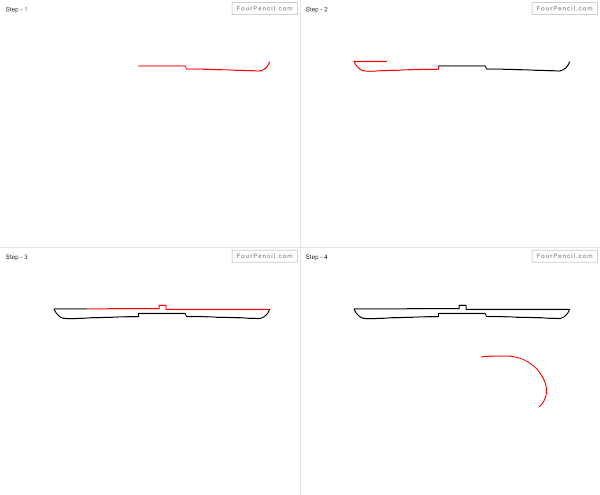 How to draw Helicopter for kids - step by step - Fact - These attributes allow helicopters to be used in congested or isolated areas where fixed-wing aircraft and many forms of VTOL (vertical takeoff and landing) aircraft cannot perform.
How to draw Helicopter for kids - step by step - Fact - These attributes allow helicopters to be used in congested or isolated areas where fixed-wing aircraft and many forms of VTOL (vertical takeoff and landing) aircraft cannot perform.  How to draw Helicopter for kids - step by step - Fact - Helicopters were developed and built during the first half-century of flight, with the Focke-Wulf Fw 61 being the first operational helicopter in 1936. Some helicopters reached limited production, but it was not until 1942 that a helicopter designed by Igor Sikorsky reached full-scale production, with 131 aircraft built.
How to draw Helicopter for kids - step by step - Fact - Helicopters were developed and built during the first half-century of flight, with the Focke-Wulf Fw 61 being the first operational helicopter in 1936. Some helicopters reached limited production, but it was not until 1942 that a helicopter designed by Igor Sikorsky reached full-scale production, with 131 aircraft built.  How to draw Helicopter for kids - step by step - Fact - Though most earlier designs used more than one main rotor, it is the single main rotor with anti-torque tail rotor configuration that has become the most common helicopter configuration. Tandem rotor helicopters are also in widespread use due to their greater payload capacity.
How to draw Helicopter for kids - step by step - Fact - Though most earlier designs used more than one main rotor, it is the single main rotor with anti-torque tail rotor configuration that has become the most common helicopter configuration. Tandem rotor helicopters are also in widespread use due to their greater payload capacity.  How to draw Helicopter for kids - step by step - Fact - Coaxial helicopters, tiltrotor aircraft, and compound helicopters are all flying today. Quadcopter helicopters pioneered as early as 1907 in France, and other types of multicopter have been developed for specialized applications such as unmanned drones.
How to draw Helicopter for kids - step by step - Fact - Coaxial helicopters, tiltrotor aircraft, and compound helicopters are all flying today. Quadcopter helicopters pioneered as early as 1907 in France, and other types of multicopter have been developed for specialized applications such as unmanned drones. 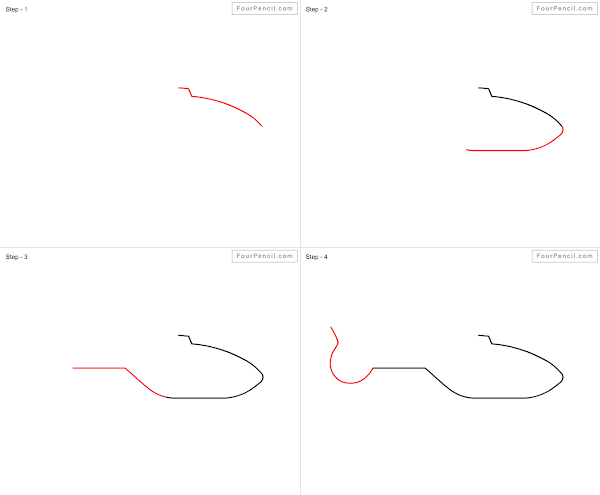 How to draw Helicopter for kids - step by step - Fact - The earliest references for vertical flight have come from China. Since around 400 BC,[8] Chinese children have played with bamboo flying toys. This bamboo-copter is spun by rolling a stick attached to a rotor. The spinning creates lift, and the toy flies when released.
How to draw Helicopter for kids - step by step - Fact - The earliest references for vertical flight have come from China. Since around 400 BC,[8] Chinese children have played with bamboo flying toys. This bamboo-copter is spun by rolling a stick attached to a rotor. The spinning creates lift, and the toy flies when released.  How to draw Helicopter for kids - step by step - Fact - The 4th-century AD Daoist book Baopuzi by Ge Hong (抱朴子 "Master who Embraces Simplicity") reportedly describes some of the ideas inherent to rotary wing aircraft.
How to draw Helicopter for kids - step by step - Fact - The 4th-century AD Daoist book Baopuzi by Ge Hong (抱朴子 "Master who Embraces Simplicity") reportedly describes some of the ideas inherent to rotary wing aircraft.  How to draw Helicopter for kids - step by step - Fact - This Chinese helicopter toy was introduced into Europe and appeared in Renaissance paintings and other works. Early Western scientists developed flying machines based on the original Chinese model.
How to draw Helicopter for kids - step by step - Fact - This Chinese helicopter toy was introduced into Europe and appeared in Renaissance paintings and other works. Early Western scientists developed flying machines based on the original Chinese model.  How to draw Helicopter easy - step by step - Fact - It was not until the early 1480s, when Leonardo da Vinci created a design for a machine that could be described as an "aerial screw", that any recorded advancement was made towards vertical flight.
How to draw Helicopter easy - step by step - Fact - It was not until the early 1480s, when Leonardo da Vinci created a design for a machine that could be described as an "aerial screw", that any recorded advancement was made towards vertical flight.  How to draw Helicopter easy - step by step - Fact - His notes suggested that he built small flying models, but there were no indications for any provision to stop the rotor from making the craft rotate. As scientific knowledge increased and became more accepted, men continued to pursue the idea of vertical flight.
How to draw Helicopter easy - step by step - Fact - His notes suggested that he built small flying models, but there were no indications for any provision to stop the rotor from making the craft rotate. As scientific knowledge increased and became more accepted, men continued to pursue the idea of vertical flight. 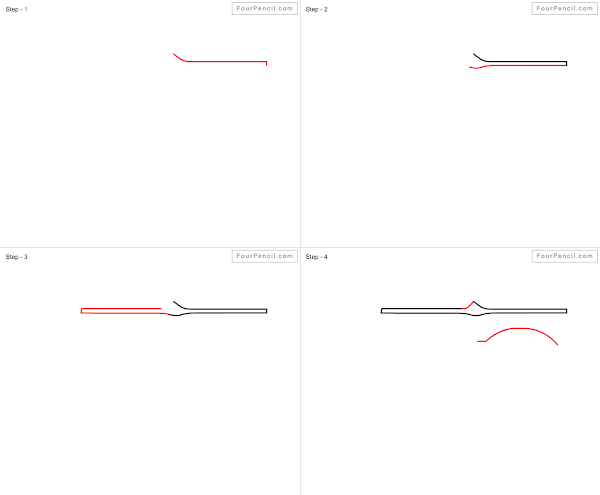 How to draw Helicopter for Beginners - Fact - Many of these later models and machines would more closely resemble the ancient bamboo flying top with spinning wings, rather than Leonardo's screw.
How to draw Helicopter for Beginners - Fact - Many of these later models and machines would more closely resemble the ancient bamboo flying top with spinning wings, rather than Leonardo's screw.  How to draw Helicopter for Beginners - Fact - In July 1754, Russian Mikhail Lomonosov had developed a small coaxial modeled after the Chinese top but powered by wound-up spring device and demonstrated it to the Russian Academy of Sciences. It was powered by a spring and suggested as a method to lift meteorological instruments.
How to draw Helicopter for Beginners - Fact - In July 1754, Russian Mikhail Lomonosov had developed a small coaxial modeled after the Chinese top but powered by wound-up spring device and demonstrated it to the Russian Academy of Sciences. It was powered by a spring and suggested as a method to lift meteorological instruments.  How to draw Helicopter for Children - Fact - In 1783, Christian de Launoy, and his mechanic, Bienvenu, used a coaxial version of Chinese top in a model consisting of a contrarotating of turkey flight feathers as rotor blades, and in 1784, demonstrated it to the French Academy of Sciences.
How to draw Helicopter for Children - Fact - In 1783, Christian de Launoy, and his mechanic, Bienvenu, used a coaxial version of Chinese top in a model consisting of a contrarotating of turkey flight feathers as rotor blades, and in 1784, demonstrated it to the French Academy of Sciences.  How to draw Helicopter for Children - Fact - Sir George Cayley, influenced by a childhood fascination with the Chinese flying top, grew up to develop a model of feathers, similar to Launoy and Bienvenu, but powered by rubber bands. By the end of the century, he had progressed to using sheets of tin for rotor blades and springs for power.
How to draw Helicopter for Children - Fact - Sir George Cayley, influenced by a childhood fascination with the Chinese flying top, grew up to develop a model of feathers, similar to Launoy and Bienvenu, but powered by rubber bands. By the end of the century, he had progressed to using sheets of tin for rotor blades and springs for power.  How to draw Helicopter for Preschoolers - Fact - His writings on his experiments and models would become influential on future aviation pioneers. Alphonse Pénaud would later develop coaxial rotor model helicopter toys in 1870, also powered by rubber bands. One of these toys, given as a gift by their father, would inspire the Wright brothers to pursue the dream of flight.[19]
How to draw Helicopter for Preschoolers - Fact - His writings on his experiments and models would become influential on future aviation pioneers. Alphonse Pénaud would later develop coaxial rotor model helicopter toys in 1870, also powered by rubber bands. One of these toys, given as a gift by their father, would inspire the Wright brothers to pursue the dream of flight.[19] 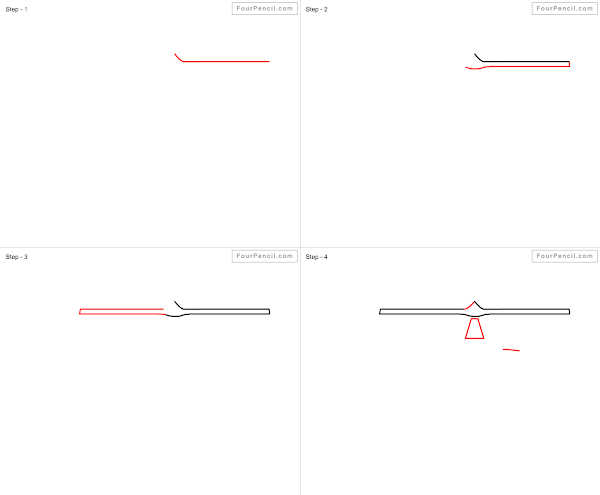 How to draw Helicopter for Preschoolers - Fact - In 1861, the word "helicopter" was coined by Gustave de Ponton d'Amécourt, a French inventor who demonstrated a small, steam-powered model. While celebrated as an innovative use of a new metal, aluminum, the model never lifted off the ground.
How to draw Helicopter for Preschoolers - Fact - In 1861, the word "helicopter" was coined by Gustave de Ponton d'Amécourt, a French inventor who demonstrated a small, steam-powered model. While celebrated as an innovative use of a new metal, aluminum, the model never lifted off the ground. 



 How to draw Helicopter for kids - step by step - Fact - These attributes allow helicopters to be used in congested or isolated areas where fixed-wing aircraft and many forms of VTOL (vertical takeoff and landing) aircraft cannot perform.
How to draw Helicopter for kids - step by step - Fact - These attributes allow helicopters to be used in congested or isolated areas where fixed-wing aircraft and many forms of VTOL (vertical takeoff and landing) aircraft cannot perform.  How to draw Helicopter for kids - step by step - Fact - Helicopters were developed and built during the first half-century of flight, with the Focke-Wulf Fw 61 being the first operational helicopter in 1936. Some helicopters reached limited production, but it was not until 1942 that a helicopter designed by Igor Sikorsky reached full-scale production, with 131 aircraft built.
How to draw Helicopter for kids - step by step - Fact - Helicopters were developed and built during the first half-century of flight, with the Focke-Wulf Fw 61 being the first operational helicopter in 1936. Some helicopters reached limited production, but it was not until 1942 that a helicopter designed by Igor Sikorsky reached full-scale production, with 131 aircraft built.  How to draw Helicopter for kids - step by step - Fact - Though most earlier designs used more than one main rotor, it is the single main rotor with anti-torque tail rotor configuration that has become the most common helicopter configuration. Tandem rotor helicopters are also in widespread use due to their greater payload capacity.
How to draw Helicopter for kids - step by step - Fact - Though most earlier designs used more than one main rotor, it is the single main rotor with anti-torque tail rotor configuration that has become the most common helicopter configuration. Tandem rotor helicopters are also in widespread use due to their greater payload capacity.  How to draw Helicopter for kids - step by step - Fact - Coaxial helicopters, tiltrotor aircraft, and compound helicopters are all flying today. Quadcopter helicopters pioneered as early as 1907 in France, and other types of multicopter have been developed for specialized applications such as unmanned drones.
How to draw Helicopter for kids - step by step - Fact - Coaxial helicopters, tiltrotor aircraft, and compound helicopters are all flying today. Quadcopter helicopters pioneered as early as 1907 in France, and other types of multicopter have been developed for specialized applications such as unmanned drones.  How to draw Helicopter for kids - step by step - Fact - The earliest references for vertical flight have come from China. Since around 400 BC,[8] Chinese children have played with bamboo flying toys. This bamboo-copter is spun by rolling a stick attached to a rotor. The spinning creates lift, and the toy flies when released.
How to draw Helicopter for kids - step by step - Fact - The earliest references for vertical flight have come from China. Since around 400 BC,[8] Chinese children have played with bamboo flying toys. This bamboo-copter is spun by rolling a stick attached to a rotor. The spinning creates lift, and the toy flies when released.  How to draw Helicopter for kids - step by step - Fact - The 4th-century AD Daoist book Baopuzi by Ge Hong (抱朴子 "Master who Embraces Simplicity") reportedly describes some of the ideas inherent to rotary wing aircraft.
How to draw Helicopter for kids - step by step - Fact - The 4th-century AD Daoist book Baopuzi by Ge Hong (抱朴子 "Master who Embraces Simplicity") reportedly describes some of the ideas inherent to rotary wing aircraft.  How to draw Helicopter for kids - step by step - Fact - This Chinese helicopter toy was introduced into Europe and appeared in Renaissance paintings and other works. Early Western scientists developed flying machines based on the original Chinese model.
How to draw Helicopter for kids - step by step - Fact - This Chinese helicopter toy was introduced into Europe and appeared in Renaissance paintings and other works. Early Western scientists developed flying machines based on the original Chinese model.  How to draw Helicopter easy - step by step - Fact - It was not until the early 1480s, when Leonardo da Vinci created a design for a machine that could be described as an "aerial screw", that any recorded advancement was made towards vertical flight.
How to draw Helicopter easy - step by step - Fact - It was not until the early 1480s, when Leonardo da Vinci created a design for a machine that could be described as an "aerial screw", that any recorded advancement was made towards vertical flight.  How to draw Helicopter easy - step by step - Fact - His notes suggested that he built small flying models, but there were no indications for any provision to stop the rotor from making the craft rotate. As scientific knowledge increased and became more accepted, men continued to pursue the idea of vertical flight.
How to draw Helicopter easy - step by step - Fact - His notes suggested that he built small flying models, but there were no indications for any provision to stop the rotor from making the craft rotate. As scientific knowledge increased and became more accepted, men continued to pursue the idea of vertical flight.  How to draw Helicopter for Beginners - Fact - Many of these later models and machines would more closely resemble the ancient bamboo flying top with spinning wings, rather than Leonardo's screw.
How to draw Helicopter for Beginners - Fact - Many of these later models and machines would more closely resemble the ancient bamboo flying top with spinning wings, rather than Leonardo's screw.  How to draw Helicopter for Beginners - Fact - In July 1754, Russian Mikhail Lomonosov had developed a small coaxial modeled after the Chinese top but powered by wound-up spring device and demonstrated it to the Russian Academy of Sciences. It was powered by a spring and suggested as a method to lift meteorological instruments.
How to draw Helicopter for Beginners - Fact - In July 1754, Russian Mikhail Lomonosov had developed a small coaxial modeled after the Chinese top but powered by wound-up spring device and demonstrated it to the Russian Academy of Sciences. It was powered by a spring and suggested as a method to lift meteorological instruments.  How to draw Helicopter for Children - Fact - In 1783, Christian de Launoy, and his mechanic, Bienvenu, used a coaxial version of Chinese top in a model consisting of a contrarotating of turkey flight feathers as rotor blades, and in 1784, demonstrated it to the French Academy of Sciences.
How to draw Helicopter for Children - Fact - In 1783, Christian de Launoy, and his mechanic, Bienvenu, used a coaxial version of Chinese top in a model consisting of a contrarotating of turkey flight feathers as rotor blades, and in 1784, demonstrated it to the French Academy of Sciences.  How to draw Helicopter for Children - Fact - Sir George Cayley, influenced by a childhood fascination with the Chinese flying top, grew up to develop a model of feathers, similar to Launoy and Bienvenu, but powered by rubber bands. By the end of the century, he had progressed to using sheets of tin for rotor blades and springs for power.
How to draw Helicopter for Children - Fact - Sir George Cayley, influenced by a childhood fascination with the Chinese flying top, grew up to develop a model of feathers, similar to Launoy and Bienvenu, but powered by rubber bands. By the end of the century, he had progressed to using sheets of tin for rotor blades and springs for power.  How to draw Helicopter for Preschoolers - Fact - His writings on his experiments and models would become influential on future aviation pioneers. Alphonse Pénaud would later develop coaxial rotor model helicopter toys in 1870, also powered by rubber bands. One of these toys, given as a gift by their father, would inspire the Wright brothers to pursue the dream of flight.[19]
How to draw Helicopter for Preschoolers - Fact - His writings on his experiments and models would become influential on future aviation pioneers. Alphonse Pénaud would later develop coaxial rotor model helicopter toys in 1870, also powered by rubber bands. One of these toys, given as a gift by their father, would inspire the Wright brothers to pursue the dream of flight.[19]  How to draw Helicopter for Preschoolers - Fact - In 1861, the word "helicopter" was coined by Gustave de Ponton d'Amécourt, a French inventor who demonstrated a small, steam-powered model. While celebrated as an innovative use of a new metal, aluminum, the model never lifted off the ground.
How to draw Helicopter for Preschoolers - Fact - In 1861, the word "helicopter" was coined by Gustave de Ponton d'Amécourt, a French inventor who demonstrated a small, steam-powered model. While celebrated as an innovative use of a new metal, aluminum, the model never lifted off the ground. 



How to draw Fox for kids step by step
How to draw Fox for kids - step by step - Fact - Foxes are small-to-medium-sized, omnivorous mammals belonging to several genera of the Canidae family. Foxes are slightly smaller than a medium-size domestic dog, with a flattened skull, upright triangular ears, a pointed, slightly upturned snout, and a long bushy tail (or brush). 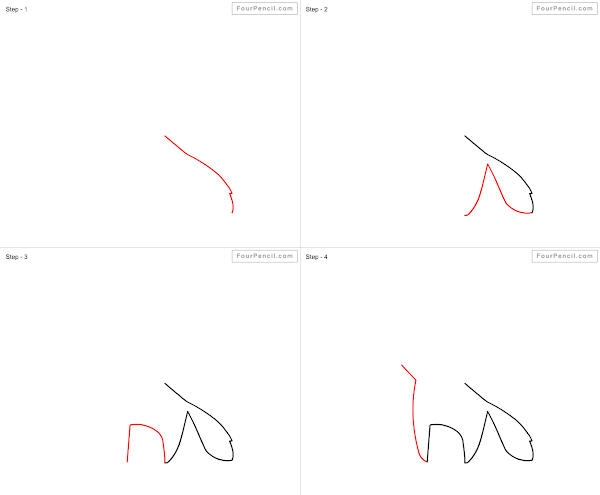 How to draw Fox for kids - step by step - Fact - Twelve species belong to the monophyletic group of Vulpes genus of "true foxes". Approximately another 25 current or extinct species are always or sometimes called foxes; these foxes are either part of the paraphyletic group of the South American foxes, or of the outlying group, which consists of bat-eared fox, gray fox, and island fox.
How to draw Fox for kids - step by step - Fact - Twelve species belong to the monophyletic group of Vulpes genus of "true foxes". Approximately another 25 current or extinct species are always or sometimes called foxes; these foxes are either part of the paraphyletic group of the South American foxes, or of the outlying group, which consists of bat-eared fox, gray fox, and island fox.  How to draw Fox for kids - step by step - Fact - Foxes are found on every continent except Antarctica. By far the most common and widespread species of fox is the red fox (Vulpes vulpes) with about 47 recognized sub-species.
How to draw Fox for kids - step by step - Fact - Foxes are found on every continent except Antarctica. By far the most common and widespread species of fox is the red fox (Vulpes vulpes) with about 47 recognized sub-species.  How to draw Fox for kids - step by step - Fact - The global distribution of foxes, together with their widespread reputation for cunning, has contributed to their prominence in popular culture and folklore in many societies around the world.
How to draw Fox for kids - step by step - Fact - The global distribution of foxes, together with their widespread reputation for cunning, has contributed to their prominence in popular culture and folklore in many societies around the world.  How to draw Fox for kids - step by step - Fact - The hunting of foxes with packs of hounds, long an established pursuit in Europe, especially in the British Isles, was exported by European settlers to various parts of the New World.
How to draw Fox for kids - step by step - Fact - The hunting of foxes with packs of hounds, long an established pursuit in Europe, especially in the British Isles, was exported by European settlers to various parts of the New World. 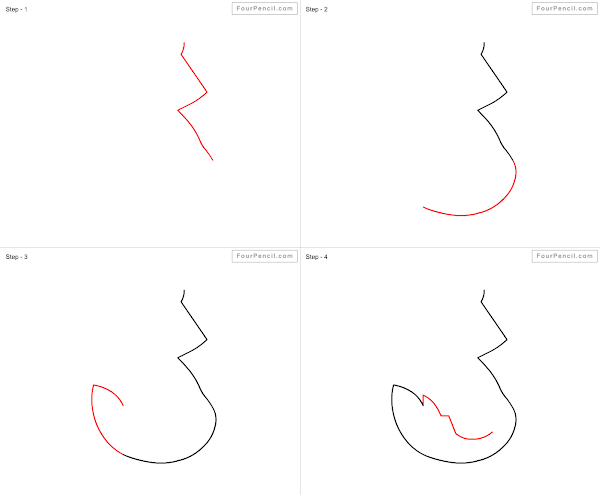 How to draw Fox for kids - step by step - Fact - Foxes are generally smaller than other members of the family Canidae such as wolves, jackals, and domestic dogs. For example, in the largest species, the red fox, males weigh on average between 4.1 and 8.7 kg (9.0 and 19.2 lb), while the smallest species, the fennec fox, weighs just 0.7 to 1.6 kg (1.5 to 3.5 lb).
How to draw Fox for kids - step by step - Fact - Foxes are generally smaller than other members of the family Canidae such as wolves, jackals, and domestic dogs. For example, in the largest species, the red fox, males weigh on average between 4.1 and 8.7 kg (9.0 and 19.2 lb), while the smallest species, the fennec fox, weighs just 0.7 to 1.6 kg (1.5 to 3.5 lb).  How to draw Fox for kids - step by step - Fact - Fox-like features typically include a triangular face, pointed ears, an elongated rostrum, and a bushy tail. Foxes are digitigrade, and thus, walk on their toes. Unlike their dog relatives, foxes have partially retractable claws.
How to draw Fox for kids - step by step - Fact - Fox-like features typically include a triangular face, pointed ears, an elongated rostrum, and a bushy tail. Foxes are digitigrade, and thus, walk on their toes. Unlike their dog relatives, foxes have partially retractable claws.  How to draw Fox for kids - step by step - Fact - Fox vibrissae, or whiskers, are black. The whiskers on the muzzle, mystaciae vibrissae, average 100-110mm long, while the whiskers everywhere else on the head average to be shorter in length. Whiskers (carpal vibrissae) are also found on the forelimbs and average to be 40mm long, pointing downward and backward. Other physical characteristics vary according to habitat and its adaptive significance.
How to draw Fox for kids - step by step - Fact - Fox vibrissae, or whiskers, are black. The whiskers on the muzzle, mystaciae vibrissae, average 100-110mm long, while the whiskers everywhere else on the head average to be shorter in length. Whiskers (carpal vibrissae) are also found on the forelimbs and average to be 40mm long, pointing downward and backward. Other physical characteristics vary according to habitat and its adaptive significance.  How to draw Fox easy - step by step - Fact - Fox species differ in fur color, length, and density. Coat colors range from pearly white to black and white to black flecked with white or grey on the underside. Fennec foxes (and other species of fox adapted to life in the desert, such as kit foxes), for example, have large ears and short fur to aid in keeping the body cool.[2][6]
How to draw Fox easy - step by step - Fact - Fox species differ in fur color, length, and density. Coat colors range from pearly white to black and white to black flecked with white or grey on the underside. Fennec foxes (and other species of fox adapted to life in the desert, such as kit foxes), for example, have large ears and short fur to aid in keeping the body cool.[2][6] 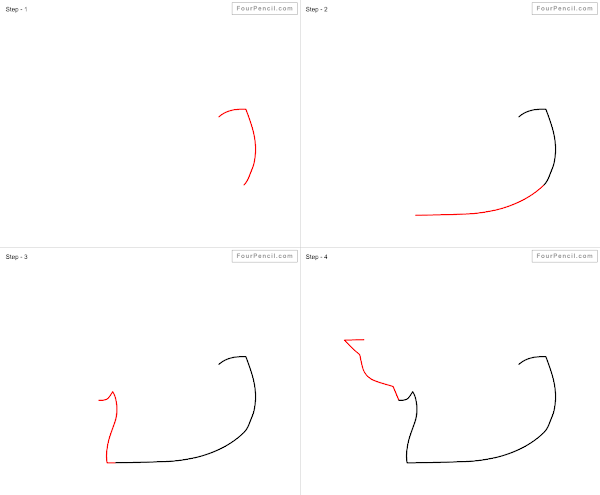 How to draw Fox easy - step by step - Fact - Arctic foxes, on the other hand, have tiny ears and short limbs as well as thick, insulating fur, which aid in keeping the body warm. Red foxes, by contrast, have a typical auburn pelt, the tail normally ending with white marking.[8]
How to draw Fox easy - step by step - Fact - Arctic foxes, on the other hand, have tiny ears and short limbs as well as thick, insulating fur, which aid in keeping the body warm. Red foxes, by contrast, have a typical auburn pelt, the tail normally ending with white marking.[8]  How to draw Fox for Beginners - Fact - A fox's coat color and texture may vary due to the change in seasons; fox pelts are richer and denser in the colder months and lighter in the warmer months.
How to draw Fox for Beginners - Fact - A fox's coat color and texture may vary due to the change in seasons; fox pelts are richer and denser in the colder months and lighter in the warmer months.  How to draw Fox for Beginners - Fact - To get rid of the dense winter coat, foxes moult once a year around April; the process begins from the feet, up the legs, and then along the back. Coat color may also change as the individual ages.
How to draw Fox for Beginners - Fact - To get rid of the dense winter coat, foxes moult once a year around April; the process begins from the feet, up the legs, and then along the back. Coat color may also change as the individual ages.  How to draw Fox for Children - Fact - In the wild, the typical lifespan of a fox is one to three years, although individuals may live up to ten years. Unlike many canids, foxes are not always pack animals. Typically, they live in small family groups, but some (Arctic foxes) are known to be solitary. Foxes are omnivores.
How to draw Fox for Children - Fact - In the wild, the typical lifespan of a fox is one to three years, although individuals may live up to ten years. Unlike many canids, foxes are not always pack animals. Typically, they live in small family groups, but some (Arctic foxes) are known to be solitary. Foxes are omnivores. 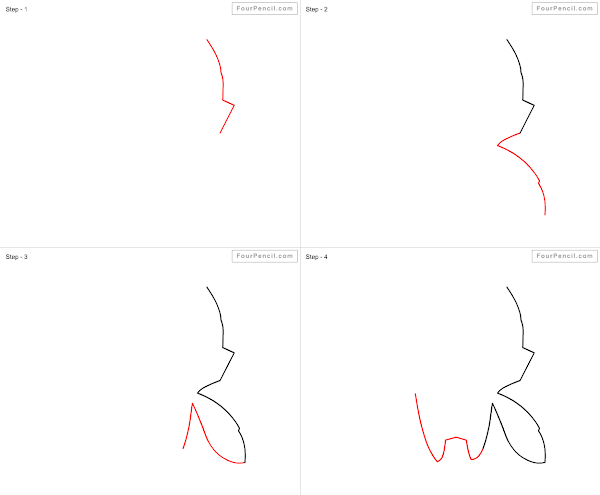 How to draw Fox for Children - Fact - The diet of foxes is largely made up of invertebrates such as insects, and small vertebrates such as reptiles and birds, and also can include eggs and plants. Many species are generalist predators, but some (such as the crab-eating fox) have more specialized diets. Most species of fox consume around 1 kg (2.2 lb) of food every day.
How to draw Fox for Children - Fact - The diet of foxes is largely made up of invertebrates such as insects, and small vertebrates such as reptiles and birds, and also can include eggs and plants. Many species are generalist predators, but some (such as the crab-eating fox) have more specialized diets. Most species of fox consume around 1 kg (2.2 lb) of food every day.  How to draw Fox for Preschoolers - Fact - Foxes cache excess food, burying it for later consumption, usually under leaves, snow, or soil. Foxes tend to use a pouncing technique where they crouch down to camouflage themselves in the terrain, then using their hind legs, leap up with great force to land on top of their targeted prey.
How to draw Fox for Preschoolers - Fact - Foxes cache excess food, burying it for later consumption, usually under leaves, snow, or soil. Foxes tend to use a pouncing technique where they crouch down to camouflage themselves in the terrain, then using their hind legs, leap up with great force to land on top of their targeted prey.  How to draw Fox for Preschoolers - Fact -
How to draw Fox for Preschoolers - Fact - 
 How to draw Fox for kids - step by step - Fact - Twelve species belong to the monophyletic group of Vulpes genus of "true foxes". Approximately another 25 current or extinct species are always or sometimes called foxes; these foxes are either part of the paraphyletic group of the South American foxes, or of the outlying group, which consists of bat-eared fox, gray fox, and island fox.
How to draw Fox for kids - step by step - Fact - Twelve species belong to the monophyletic group of Vulpes genus of "true foxes". Approximately another 25 current or extinct species are always or sometimes called foxes; these foxes are either part of the paraphyletic group of the South American foxes, or of the outlying group, which consists of bat-eared fox, gray fox, and island fox.  How to draw Fox for kids - step by step - Fact - Foxes are found on every continent except Antarctica. By far the most common and widespread species of fox is the red fox (Vulpes vulpes) with about 47 recognized sub-species.
How to draw Fox for kids - step by step - Fact - Foxes are found on every continent except Antarctica. By far the most common and widespread species of fox is the red fox (Vulpes vulpes) with about 47 recognized sub-species.  How to draw Fox for kids - step by step - Fact - The global distribution of foxes, together with their widespread reputation for cunning, has contributed to their prominence in popular culture and folklore in many societies around the world.
How to draw Fox for kids - step by step - Fact - The global distribution of foxes, together with their widespread reputation for cunning, has contributed to their prominence in popular culture and folklore in many societies around the world.  How to draw Fox for kids - step by step - Fact - The hunting of foxes with packs of hounds, long an established pursuit in Europe, especially in the British Isles, was exported by European settlers to various parts of the New World.
How to draw Fox for kids - step by step - Fact - The hunting of foxes with packs of hounds, long an established pursuit in Europe, especially in the British Isles, was exported by European settlers to various parts of the New World.  How to draw Fox for kids - step by step - Fact - Foxes are generally smaller than other members of the family Canidae such as wolves, jackals, and domestic dogs. For example, in the largest species, the red fox, males weigh on average between 4.1 and 8.7 kg (9.0 and 19.2 lb), while the smallest species, the fennec fox, weighs just 0.7 to 1.6 kg (1.5 to 3.5 lb).
How to draw Fox for kids - step by step - Fact - Foxes are generally smaller than other members of the family Canidae such as wolves, jackals, and domestic dogs. For example, in the largest species, the red fox, males weigh on average between 4.1 and 8.7 kg (9.0 and 19.2 lb), while the smallest species, the fennec fox, weighs just 0.7 to 1.6 kg (1.5 to 3.5 lb).  How to draw Fox for kids - step by step - Fact - Fox-like features typically include a triangular face, pointed ears, an elongated rostrum, and a bushy tail. Foxes are digitigrade, and thus, walk on their toes. Unlike their dog relatives, foxes have partially retractable claws.
How to draw Fox for kids - step by step - Fact - Fox-like features typically include a triangular face, pointed ears, an elongated rostrum, and a bushy tail. Foxes are digitigrade, and thus, walk on their toes. Unlike their dog relatives, foxes have partially retractable claws.  How to draw Fox for kids - step by step - Fact - Fox vibrissae, or whiskers, are black. The whiskers on the muzzle, mystaciae vibrissae, average 100-110mm long, while the whiskers everywhere else on the head average to be shorter in length. Whiskers (carpal vibrissae) are also found on the forelimbs and average to be 40mm long, pointing downward and backward. Other physical characteristics vary according to habitat and its adaptive significance.
How to draw Fox for kids - step by step - Fact - Fox vibrissae, or whiskers, are black. The whiskers on the muzzle, mystaciae vibrissae, average 100-110mm long, while the whiskers everywhere else on the head average to be shorter in length. Whiskers (carpal vibrissae) are also found on the forelimbs and average to be 40mm long, pointing downward and backward. Other physical characteristics vary according to habitat and its adaptive significance.  How to draw Fox easy - step by step - Fact - Fox species differ in fur color, length, and density. Coat colors range from pearly white to black and white to black flecked with white or grey on the underside. Fennec foxes (and other species of fox adapted to life in the desert, such as kit foxes), for example, have large ears and short fur to aid in keeping the body cool.[2][6]
How to draw Fox easy - step by step - Fact - Fox species differ in fur color, length, and density. Coat colors range from pearly white to black and white to black flecked with white or grey on the underside. Fennec foxes (and other species of fox adapted to life in the desert, such as kit foxes), for example, have large ears and short fur to aid in keeping the body cool.[2][6]  How to draw Fox easy - step by step - Fact - Arctic foxes, on the other hand, have tiny ears and short limbs as well as thick, insulating fur, which aid in keeping the body warm. Red foxes, by contrast, have a typical auburn pelt, the tail normally ending with white marking.[8]
How to draw Fox easy - step by step - Fact - Arctic foxes, on the other hand, have tiny ears and short limbs as well as thick, insulating fur, which aid in keeping the body warm. Red foxes, by contrast, have a typical auburn pelt, the tail normally ending with white marking.[8]  How to draw Fox for Beginners - Fact - A fox's coat color and texture may vary due to the change in seasons; fox pelts are richer and denser in the colder months and lighter in the warmer months.
How to draw Fox for Beginners - Fact - A fox's coat color and texture may vary due to the change in seasons; fox pelts are richer and denser in the colder months and lighter in the warmer months.  How to draw Fox for Beginners - Fact - To get rid of the dense winter coat, foxes moult once a year around April; the process begins from the feet, up the legs, and then along the back. Coat color may also change as the individual ages.
How to draw Fox for Beginners - Fact - To get rid of the dense winter coat, foxes moult once a year around April; the process begins from the feet, up the legs, and then along the back. Coat color may also change as the individual ages.  How to draw Fox for Children - Fact - In the wild, the typical lifespan of a fox is one to three years, although individuals may live up to ten years. Unlike many canids, foxes are not always pack animals. Typically, they live in small family groups, but some (Arctic foxes) are known to be solitary. Foxes are omnivores.
How to draw Fox for Children - Fact - In the wild, the typical lifespan of a fox is one to three years, although individuals may live up to ten years. Unlike many canids, foxes are not always pack animals. Typically, they live in small family groups, but some (Arctic foxes) are known to be solitary. Foxes are omnivores.  How to draw Fox for Children - Fact - The diet of foxes is largely made up of invertebrates such as insects, and small vertebrates such as reptiles and birds, and also can include eggs and plants. Many species are generalist predators, but some (such as the crab-eating fox) have more specialized diets. Most species of fox consume around 1 kg (2.2 lb) of food every day.
How to draw Fox for Children - Fact - The diet of foxes is largely made up of invertebrates such as insects, and small vertebrates such as reptiles and birds, and also can include eggs and plants. Many species are generalist predators, but some (such as the crab-eating fox) have more specialized diets. Most species of fox consume around 1 kg (2.2 lb) of food every day.  How to draw Fox for Preschoolers - Fact - Foxes cache excess food, burying it for later consumption, usually under leaves, snow, or soil. Foxes tend to use a pouncing technique where they crouch down to camouflage themselves in the terrain, then using their hind legs, leap up with great force to land on top of their targeted prey.
How to draw Fox for Preschoolers - Fact - Foxes cache excess food, burying it for later consumption, usually under leaves, snow, or soil. Foxes tend to use a pouncing technique where they crouch down to camouflage themselves in the terrain, then using their hind legs, leap up with great force to land on top of their targeted prey.  How to draw Fox for Preschoolers - Fact -
How to draw Fox for Preschoolers - Fact - 
How to draw Squirrel for kids step by step
How to draw Squirrel for kids - step by step - Fact - Squirrels are members of the family Sciuridae, consisting of small or medium-size rodents. The family includes tree squirrels, ground squirrels, chipmunks, marmots (including woodchucks), flying squirrels, and prairie dogs. 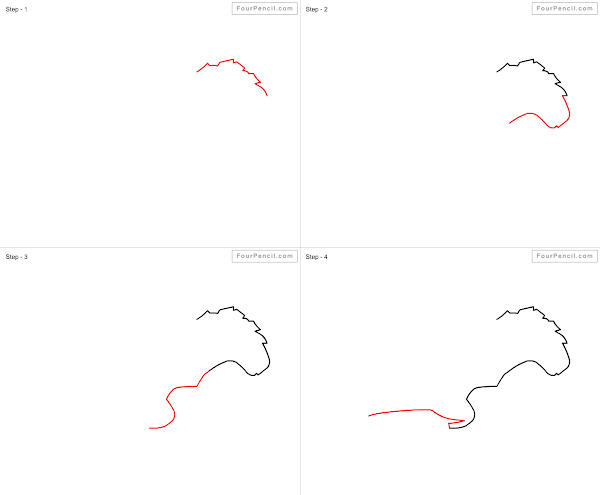 How to draw Squirrel for kids - step by step - Fact - Squirrels are indigenous to the Americas, Eurasia, and Africa, and have been introduced to Australia.
How to draw Squirrel for kids - step by step - Fact - Squirrels are indigenous to the Americas, Eurasia, and Africa, and have been introduced to Australia.  How to draw Squirrel for kids - step by step - Fact - The earliest known squirrels date from the Eocene and are most closely related to the mountain beaver and to the dormouse among living rodent families.
How to draw Squirrel for kids - step by step - Fact - The earliest known squirrels date from the Eocene and are most closely related to the mountain beaver and to the dormouse among living rodent families.  How to draw Squirrel for kids - step by step - Fact - That word "squirrel", first specified in 1327, comes from the Anglo-Norman esquirel which is from the Old French escurel, the reflex of a Latin word sciurus.
How to draw Squirrel for kids - step by step - Fact - That word "squirrel", first specified in 1327, comes from the Anglo-Norman esquirel which is from the Old French escurel, the reflex of a Latin word sciurus. 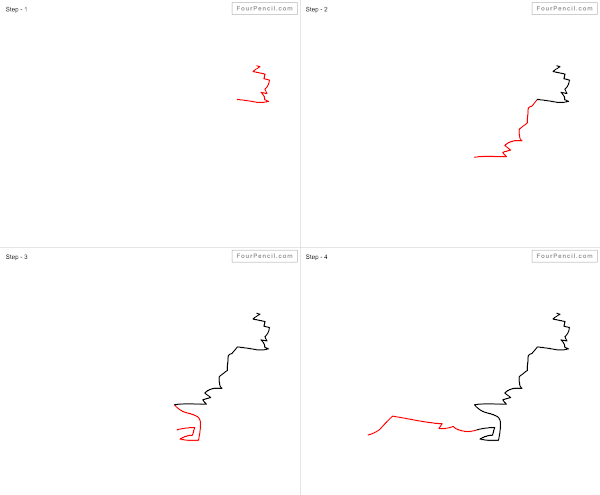 How to draw Squirrel for kids - step by step - Fact - This Latin word was borrowed from the Ancient Greek word σκίουρος, skiouros, which means shadow-tailed, referring to the bushy appendage possessed by many of its members.
How to draw Squirrel for kids - step by step - Fact - This Latin word was borrowed from the Ancient Greek word σκίουρος, skiouros, which means shadow-tailed, referring to the bushy appendage possessed by many of its members.  How to draw Squirrel for kids - step by step - Fact - The native Old English word for the squirrel, ācweorna, survived only into Middle English (as aquerne) before being replaced.
How to draw Squirrel for kids - step by step - Fact - The native Old English word for the squirrel, ācweorna, survived only into Middle English (as aquerne) before being replaced.  How to draw Squirrel for kids - step by step - Fact - The Old English word is of Common Germanic origin, cognates of which are still used in other Germanic languages, including the German Eichhörnchen (diminutive of Eichhorn, which is not used), the Norwegian ikorn/ekorn, the Dutch eekhoorn, the Swedish ekorre and the Danish egern.
How to draw Squirrel for kids - step by step - Fact - The Old English word is of Common Germanic origin, cognates of which are still used in other Germanic languages, including the German Eichhörnchen (diminutive of Eichhorn, which is not used), the Norwegian ikorn/ekorn, the Dutch eekhoorn, the Swedish ekorre and the Danish egern. 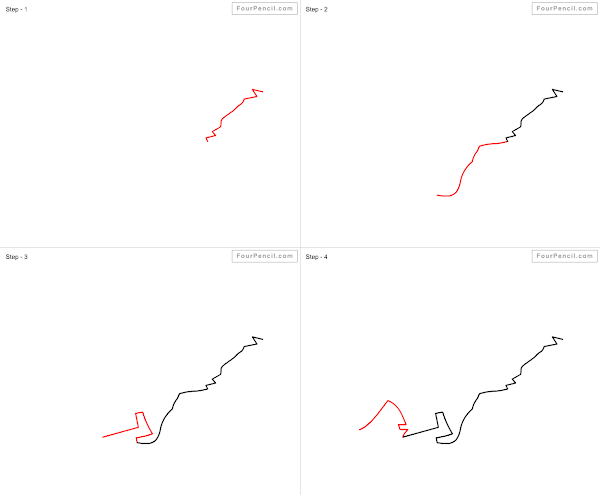 How to draw Squirrel for kids - step by step - Fact - Squirrels are generally small animals, ranging in size from the African pygmy squirrel at 7–10 cm (2.8–3.9 in) in length and just 10 g (0.35 oz) in weight, to the Alpine marmot, which is 53–73 cm (21–29 in) long and weighs from 5 to 8 kg (11 to 18 lb).
How to draw Squirrel for kids - step by step - Fact - Squirrels are generally small animals, ranging in size from the African pygmy squirrel at 7–10 cm (2.8–3.9 in) in length and just 10 g (0.35 oz) in weight, to the Alpine marmot, which is 53–73 cm (21–29 in) long and weighs from 5 to 8 kg (11 to 18 lb).  How to draw Squirrel easy - step by step - Fact - Squirrels typically have slender bodies with bushy tails and large eyes. In general, their fur is soft and silky, although much thicker in some species than others. The color of squirrels is highly variable between—and often even within—species.
How to draw Squirrel easy - step by step - Fact - Squirrels typically have slender bodies with bushy tails and large eyes. In general, their fur is soft and silky, although much thicker in some species than others. The color of squirrels is highly variable between—and often even within—species.  How to draw Squirrel easy - step by step - Fact - In general, the hind limbs are longer than the fore limbs, and they have four or five toes on each paw.
How to draw Squirrel easy - step by step - Fact - In general, the hind limbs are longer than the fore limbs, and they have four or five toes on each paw.  How to draw Squirrel for Beginners - Fact - Their paws include an often poorly developed thumb, and have soft pads on the undersides. Unlike most mammals, Tree squirrels can descend a tree head-first.
How to draw Squirrel for Beginners - Fact - Their paws include an often poorly developed thumb, and have soft pads on the undersides. Unlike most mammals, Tree squirrels can descend a tree head-first. 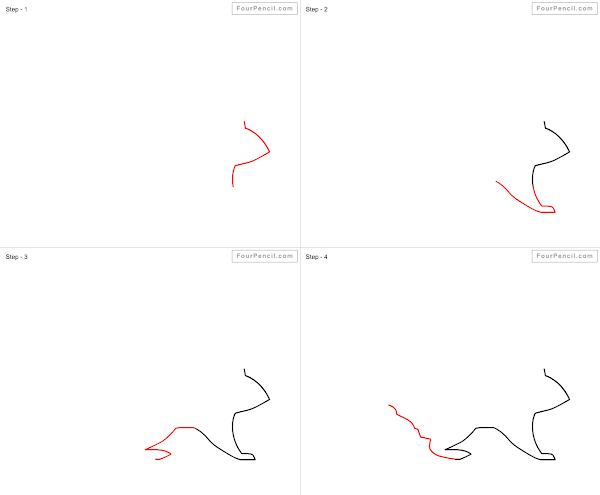 How to draw Squirrel for Beginners - Fact - They do so by rotating their ankles 180 degrees so the hind paws are backward-pointing and can grip the tree bark.
How to draw Squirrel for Beginners - Fact - They do so by rotating their ankles 180 degrees so the hind paws are backward-pointing and can grip the tree bark.  How to draw Squirrel for Children - Fact - Squirrels live in almost every habitat from tropical rainforest to semiarid desert, avoiding only the high polar regions and the driest of deserts. They are predominantly herbivorous, subsisting on seeds and nuts, but many will eat insects and even small vertebrates.
How to draw Squirrel for Children - Fact - Squirrels live in almost every habitat from tropical rainforest to semiarid desert, avoiding only the high polar regions and the driest of deserts. They are predominantly herbivorous, subsisting on seeds and nuts, but many will eat insects and even small vertebrates.  How to draw Squirrel for Children - Fact - As their large eyes indicate, in general squirrels have an excellent sense of vision, which is especially important for tree-dwelling species. They also have very versatile and sturdy claws for grasping and climbing.[9] Many also have a good sense of touch, with vibrissae on their heads and limbs.
How to draw Squirrel for Children - Fact - As their large eyes indicate, in general squirrels have an excellent sense of vision, which is especially important for tree-dwelling species. They also have very versatile and sturdy claws for grasping and climbing.[9] Many also have a good sense of touch, with vibrissae on their heads and limbs. 
 How to draw Squirrel for kids - step by step - Fact - Squirrels are indigenous to the Americas, Eurasia, and Africa, and have been introduced to Australia.
How to draw Squirrel for kids - step by step - Fact - Squirrels are indigenous to the Americas, Eurasia, and Africa, and have been introduced to Australia.  How to draw Squirrel for kids - step by step - Fact - The earliest known squirrels date from the Eocene and are most closely related to the mountain beaver and to the dormouse among living rodent families.
How to draw Squirrel for kids - step by step - Fact - The earliest known squirrels date from the Eocene and are most closely related to the mountain beaver and to the dormouse among living rodent families.  How to draw Squirrel for kids - step by step - Fact - That word "squirrel", first specified in 1327, comes from the Anglo-Norman esquirel which is from the Old French escurel, the reflex of a Latin word sciurus.
How to draw Squirrel for kids - step by step - Fact - That word "squirrel", first specified in 1327, comes from the Anglo-Norman esquirel which is from the Old French escurel, the reflex of a Latin word sciurus.  How to draw Squirrel for kids - step by step - Fact - This Latin word was borrowed from the Ancient Greek word σκίουρος, skiouros, which means shadow-tailed, referring to the bushy appendage possessed by many of its members.
How to draw Squirrel for kids - step by step - Fact - This Latin word was borrowed from the Ancient Greek word σκίουρος, skiouros, which means shadow-tailed, referring to the bushy appendage possessed by many of its members.  How to draw Squirrel for kids - step by step - Fact - The native Old English word for the squirrel, ācweorna, survived only into Middle English (as aquerne) before being replaced.
How to draw Squirrel for kids - step by step - Fact - The native Old English word for the squirrel, ācweorna, survived only into Middle English (as aquerne) before being replaced.  How to draw Squirrel for kids - step by step - Fact - The Old English word is of Common Germanic origin, cognates of which are still used in other Germanic languages, including the German Eichhörnchen (diminutive of Eichhorn, which is not used), the Norwegian ikorn/ekorn, the Dutch eekhoorn, the Swedish ekorre and the Danish egern.
How to draw Squirrel for kids - step by step - Fact - The Old English word is of Common Germanic origin, cognates of which are still used in other Germanic languages, including the German Eichhörnchen (diminutive of Eichhorn, which is not used), the Norwegian ikorn/ekorn, the Dutch eekhoorn, the Swedish ekorre and the Danish egern.  How to draw Squirrel for kids - step by step - Fact - Squirrels are generally small animals, ranging in size from the African pygmy squirrel at 7–10 cm (2.8–3.9 in) in length and just 10 g (0.35 oz) in weight, to the Alpine marmot, which is 53–73 cm (21–29 in) long and weighs from 5 to 8 kg (11 to 18 lb).
How to draw Squirrel for kids - step by step - Fact - Squirrels are generally small animals, ranging in size from the African pygmy squirrel at 7–10 cm (2.8–3.9 in) in length and just 10 g (0.35 oz) in weight, to the Alpine marmot, which is 53–73 cm (21–29 in) long and weighs from 5 to 8 kg (11 to 18 lb).  How to draw Squirrel easy - step by step - Fact - Squirrels typically have slender bodies with bushy tails and large eyes. In general, their fur is soft and silky, although much thicker in some species than others. The color of squirrels is highly variable between—and often even within—species.
How to draw Squirrel easy - step by step - Fact - Squirrels typically have slender bodies with bushy tails and large eyes. In general, their fur is soft and silky, although much thicker in some species than others. The color of squirrels is highly variable between—and often even within—species.  How to draw Squirrel easy - step by step - Fact - In general, the hind limbs are longer than the fore limbs, and they have four or five toes on each paw.
How to draw Squirrel easy - step by step - Fact - In general, the hind limbs are longer than the fore limbs, and they have four or five toes on each paw.  How to draw Squirrel for Beginners - Fact - Their paws include an often poorly developed thumb, and have soft pads on the undersides. Unlike most mammals, Tree squirrels can descend a tree head-first.
How to draw Squirrel for Beginners - Fact - Their paws include an often poorly developed thumb, and have soft pads on the undersides. Unlike most mammals, Tree squirrels can descend a tree head-first.  How to draw Squirrel for Beginners - Fact - They do so by rotating their ankles 180 degrees so the hind paws are backward-pointing and can grip the tree bark.
How to draw Squirrel for Beginners - Fact - They do so by rotating their ankles 180 degrees so the hind paws are backward-pointing and can grip the tree bark.  How to draw Squirrel for Children - Fact - Squirrels live in almost every habitat from tropical rainforest to semiarid desert, avoiding only the high polar regions and the driest of deserts. They are predominantly herbivorous, subsisting on seeds and nuts, but many will eat insects and even small vertebrates.
How to draw Squirrel for Children - Fact - Squirrels live in almost every habitat from tropical rainforest to semiarid desert, avoiding only the high polar regions and the driest of deserts. They are predominantly herbivorous, subsisting on seeds and nuts, but many will eat insects and even small vertebrates.  How to draw Squirrel for Children - Fact - As their large eyes indicate, in general squirrels have an excellent sense of vision, which is especially important for tree-dwelling species. They also have very versatile and sturdy claws for grasping and climbing.[9] Many also have a good sense of touch, with vibrissae on their heads and limbs.
How to draw Squirrel for Children - Fact - As their large eyes indicate, in general squirrels have an excellent sense of vision, which is especially important for tree-dwelling species. They also have very versatile and sturdy claws for grasping and climbing.[9] Many also have a good sense of touch, with vibrissae on their heads and limbs. 
How to draw Rabbit for kids step by step
How to draw Rabbit for kids - step by step - Fact - Rabbits are small mammals in the family Leporidae of the order Lagomorpha, found in several parts of the world. There are eight different genera in the family classified as rabbits, including the European rabbit (Oryctolagus cuniculus), cottontail rabbits (genus Sylvilagus; 13 species), and the Amami rabbit (Pentalagus furnessi, an endangered species on Amami Ōshima, Japan). 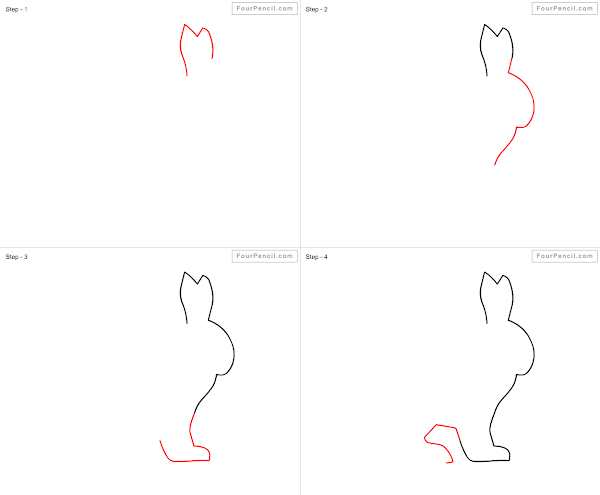 How to draw Rabbit for kids - step by step - Fact - There are many other species of rabbit, and these, along with pikas and hares, make up the order Lagomorpha. The male is called a buck and the female is a doe; a young rabbit is a kitten or kit.
How to draw Rabbit for kids - step by step - Fact - There are many other species of rabbit, and these, along with pikas and hares, make up the order Lagomorpha. The male is called a buck and the female is a doe; a young rabbit is a kitten or kit.  How to draw Rabbit for kids - step by step - Fact - Rabbit habitats include meadows, woods, forests, grasslands, deserts and wetlands. Rabbits live in groups, and the best known species, the European rabbit, lives in underground burrows, or rabbit holes. A group of burrows is called a warren.
How to draw Rabbit for kids - step by step - Fact - Rabbit habitats include meadows, woods, forests, grasslands, deserts and wetlands. Rabbits live in groups, and the best known species, the European rabbit, lives in underground burrows, or rabbit holes. A group of burrows is called a warren.  How to draw Rabbit for kids - step by step - Fact - More than half the world's rabbit population resides in North America. They are also native to southwestern Europe, Southeast Asia, Sumatra, some islands of Japan, and in parts of Africa and South America. They are not naturally found in most of Eurasia, where a number of species of hares are present.
How to draw Rabbit for kids - step by step - Fact - More than half the world's rabbit population resides in North America. They are also native to southwestern Europe, Southeast Asia, Sumatra, some islands of Japan, and in parts of Africa and South America. They are not naturally found in most of Eurasia, where a number of species of hares are present. 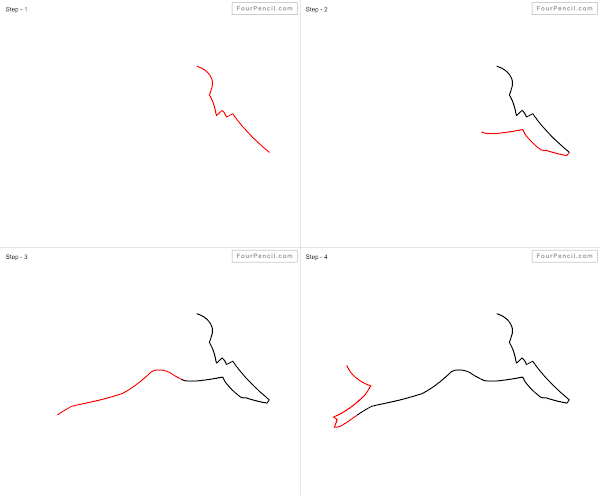 How to draw Rabbit for kids - step by step - Fact - Rabbits first entered South America relatively recently, as part of the Great American Interchange. Much of the continent has just one species of rabbit, the tapeti, while most of South America's southern cone is without rabbits.
How to draw Rabbit for kids - step by step - Fact - Rabbits first entered South America relatively recently, as part of the Great American Interchange. Much of the continent has just one species of rabbit, the tapeti, while most of South America's southern cone is without rabbits.  How to draw Rabbit for kids - step by step - Fact - The European rabbit has been introduced to many places around the world.
How to draw Rabbit for kids - step by step - Fact - The European rabbit has been introduced to many places around the world.  How to draw Rabbit for kids - step by step - Fact - Because the rabbit's epiglottis is engaged over the soft palate except when swallowing, the rabbit is an obligate nasal breather. Rabbits have two sets of incisor teeth, one behind the other.
How to draw Rabbit for kids - step by step - Fact - Because the rabbit's epiglottis is engaged over the soft palate except when swallowing, the rabbit is an obligate nasal breather. Rabbits have two sets of incisor teeth, one behind the other. 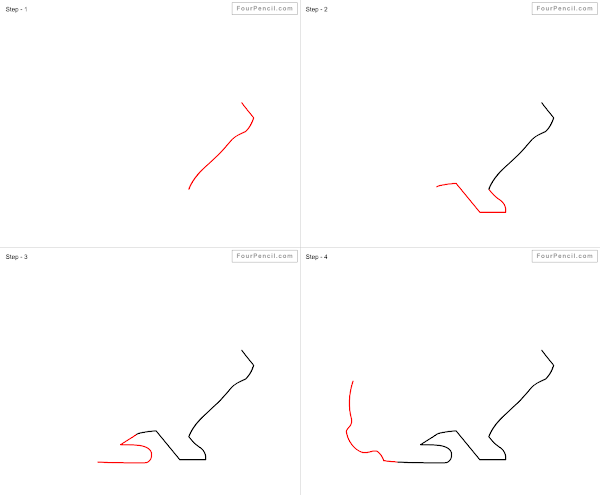 How to draw Rabbit for kids - step by step - Fact - This way they can be distinguished from rodents, with which they are often confused. Carl Linnaeus originally grouped rabbits and rodents under the class Glires; later, they were separated as the scientific consensus is that many of their similarities were a result of convergent evolution.
How to draw Rabbit for kids - step by step - Fact - This way they can be distinguished from rodents, with which they are often confused. Carl Linnaeus originally grouped rabbits and rodents under the class Glires; later, they were separated as the scientific consensus is that many of their similarities were a result of convergent evolution.  How to draw Rabbit easy - step by step - Fact - However, recent DNA analysis and the discovery of a common ancestor has supported the view that they share a common lineage, and thus rabbits and rodents are now often referred to together as members of the superorder Glires.
How to draw Rabbit easy - step by step - Fact - However, recent DNA analysis and the discovery of a common ancestor has supported the view that they share a common lineage, and thus rabbits and rodents are now often referred to together as members of the superorder Glires.  How to draw Rabbit easy - step by step - Fact - The rabbit's long ears, which can be more than 10 cm (4 in) long, are probably an adaptation for detecting predators. They have large, powerful hind legs. The two front paws have 5 toes, the extra called the dewclaw.
How to draw Rabbit easy - step by step - Fact - The rabbit's long ears, which can be more than 10 cm (4 in) long, are probably an adaptation for detecting predators. They have large, powerful hind legs. The two front paws have 5 toes, the extra called the dewclaw. 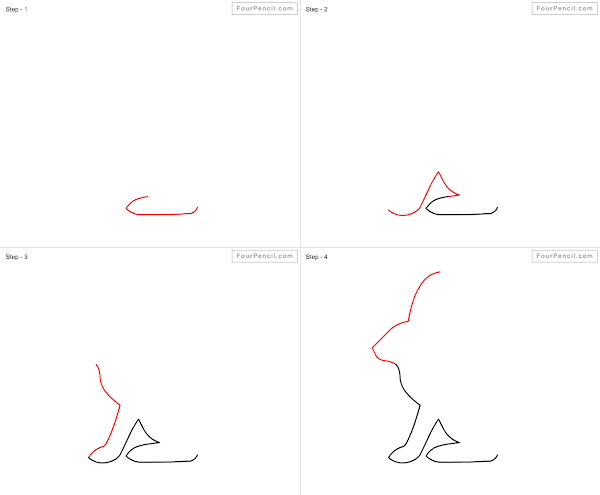 How to draw Rabbit for Beginners - Fact - The hind feet have 4 toes. They are plantigrade animals while at rest; however, they move around on their toes while running, assuming a more digitigrade form. Unlike some other paw structures of quadruped mammals, especially those of domesticated pets, rabbit paws lack pads.[citation needed]
How to draw Rabbit for Beginners - Fact - The hind feet have 4 toes. They are plantigrade animals while at rest; however, they move around on their toes while running, assuming a more digitigrade form. Unlike some other paw structures of quadruped mammals, especially those of domesticated pets, rabbit paws lack pads.[citation needed]  How to draw Rabbit for Beginners - Fact - Their nails are strong and are used for digging; along with their teeth, they are also used for defense.[citation needed]
How to draw Rabbit for Beginners - Fact - Their nails are strong and are used for digging; along with their teeth, they are also used for defense.[citation needed] 
 How to draw Rabbit for kids - step by step - Fact - There are many other species of rabbit, and these, along with pikas and hares, make up the order Lagomorpha. The male is called a buck and the female is a doe; a young rabbit is a kitten or kit.
How to draw Rabbit for kids - step by step - Fact - There are many other species of rabbit, and these, along with pikas and hares, make up the order Lagomorpha. The male is called a buck and the female is a doe; a young rabbit is a kitten or kit.  How to draw Rabbit for kids - step by step - Fact - Rabbit habitats include meadows, woods, forests, grasslands, deserts and wetlands. Rabbits live in groups, and the best known species, the European rabbit, lives in underground burrows, or rabbit holes. A group of burrows is called a warren.
How to draw Rabbit for kids - step by step - Fact - Rabbit habitats include meadows, woods, forests, grasslands, deserts and wetlands. Rabbits live in groups, and the best known species, the European rabbit, lives in underground burrows, or rabbit holes. A group of burrows is called a warren.  How to draw Rabbit for kids - step by step - Fact - More than half the world's rabbit population resides in North America. They are also native to southwestern Europe, Southeast Asia, Sumatra, some islands of Japan, and in parts of Africa and South America. They are not naturally found in most of Eurasia, where a number of species of hares are present.
How to draw Rabbit for kids - step by step - Fact - More than half the world's rabbit population resides in North America. They are also native to southwestern Europe, Southeast Asia, Sumatra, some islands of Japan, and in parts of Africa and South America. They are not naturally found in most of Eurasia, where a number of species of hares are present.  How to draw Rabbit for kids - step by step - Fact - Rabbits first entered South America relatively recently, as part of the Great American Interchange. Much of the continent has just one species of rabbit, the tapeti, while most of South America's southern cone is without rabbits.
How to draw Rabbit for kids - step by step - Fact - Rabbits first entered South America relatively recently, as part of the Great American Interchange. Much of the continent has just one species of rabbit, the tapeti, while most of South America's southern cone is without rabbits.  How to draw Rabbit for kids - step by step - Fact - The European rabbit has been introduced to many places around the world.
How to draw Rabbit for kids - step by step - Fact - The European rabbit has been introduced to many places around the world.  How to draw Rabbit for kids - step by step - Fact - Because the rabbit's epiglottis is engaged over the soft palate except when swallowing, the rabbit is an obligate nasal breather. Rabbits have two sets of incisor teeth, one behind the other.
How to draw Rabbit for kids - step by step - Fact - Because the rabbit's epiglottis is engaged over the soft palate except when swallowing, the rabbit is an obligate nasal breather. Rabbits have two sets of incisor teeth, one behind the other.  How to draw Rabbit for kids - step by step - Fact - This way they can be distinguished from rodents, with which they are often confused. Carl Linnaeus originally grouped rabbits and rodents under the class Glires; later, they were separated as the scientific consensus is that many of their similarities were a result of convergent evolution.
How to draw Rabbit for kids - step by step - Fact - This way they can be distinguished from rodents, with which they are often confused. Carl Linnaeus originally grouped rabbits and rodents under the class Glires; later, they were separated as the scientific consensus is that many of their similarities were a result of convergent evolution.  How to draw Rabbit easy - step by step - Fact - However, recent DNA analysis and the discovery of a common ancestor has supported the view that they share a common lineage, and thus rabbits and rodents are now often referred to together as members of the superorder Glires.
How to draw Rabbit easy - step by step - Fact - However, recent DNA analysis and the discovery of a common ancestor has supported the view that they share a common lineage, and thus rabbits and rodents are now often referred to together as members of the superorder Glires.  How to draw Rabbit easy - step by step - Fact - The rabbit's long ears, which can be more than 10 cm (4 in) long, are probably an adaptation for detecting predators. They have large, powerful hind legs. The two front paws have 5 toes, the extra called the dewclaw.
How to draw Rabbit easy - step by step - Fact - The rabbit's long ears, which can be more than 10 cm (4 in) long, are probably an adaptation for detecting predators. They have large, powerful hind legs. The two front paws have 5 toes, the extra called the dewclaw.  How to draw Rabbit for Beginners - Fact - The hind feet have 4 toes. They are plantigrade animals while at rest; however, they move around on their toes while running, assuming a more digitigrade form. Unlike some other paw structures of quadruped mammals, especially those of domesticated pets, rabbit paws lack pads.[citation needed]
How to draw Rabbit for Beginners - Fact - The hind feet have 4 toes. They are plantigrade animals while at rest; however, they move around on their toes while running, assuming a more digitigrade form. Unlike some other paw structures of quadruped mammals, especially those of domesticated pets, rabbit paws lack pads.[citation needed]  How to draw Rabbit for Beginners - Fact - Their nails are strong and are used for digging; along with their teeth, they are also used for defense.[citation needed]
How to draw Rabbit for Beginners - Fact - Their nails are strong and are used for digging; along with their teeth, they are also used for defense.[citation needed] 
Subscribe to:
Posts (Atom)
